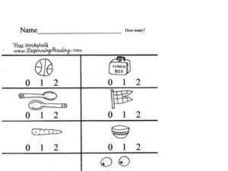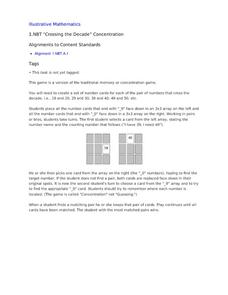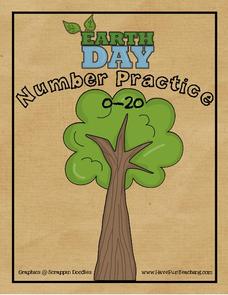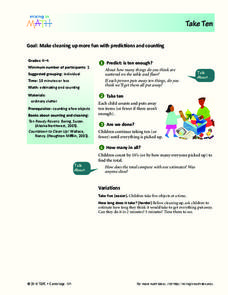Curated OER
Parts of a Set
Calling all fraction novices! Use sets of objects to introduce scholars to fractions before they even have learned about numerators and denominators (but this is a great way to introduce these terms!). The first section has four...
Curated OER
How Many?
Establish 1:1 correspondence by counting students, first one gender, then the other. Give each child a colored cube (one color for boys, another for girls) and have small groups determine more or less and how many all together. As a...
Curated OER
Estimate How Many Seeds Are In a Fruit or Vegetable
Help mathematicians estimate how many seeds are in a given vegetable or fruit. They are divided into pairs and estimate the amount of seeds in a whole fruit without seeing the inside. They then cut the fruit or vegetable in half and...
Curated OER
Counting Money
Money is always a source of interest for young mathematicians, so utilize their engagement by adding up coin values. For each set of coins (quarter, dime, nickel, and penny) scholars count up and write the total. The example has them...
Illustrative Mathematics
Counting by Tens
With this daily counting activity, your kindergartners will master counting in sequence automatically from 0 to 100, and will count in multiples of ten to 100. With the whole class, count to 100. With each number, learners will whisper...
Curated OER
Counting up to 20
In this counting worksheet, students count sets of objects, writing the total number next to each set, counting to 20 only.
Curated OER
Counting to Two
In this counting to 2 worksheet, students solve 8 problems in which objects in a set are counted. From a list of 3 choices, students circle the number that tells how many.
Curated OER
How Many? Count to 20
In this counting to 20 activity, students count rows of objects, writing totals beside each set, 8 total. An answer key is included on page 3.
Curated OER
Counting up to 20
In this counting objects worksheet, learners examine 10 sets of pictures and identify the number of pictures in each set.
Illustrative Mathematics
“Crossing the Decade” Concentration
Young mathematicians concentrate on learning to fluently count. Following the rules of the classic game Memory, children take turns flipping over cards in order to find pairs of numbers that cross a decade (e.g. 29 and 30). For younger...
Have Fun Teaching
Earth Day Number Practice 0-20
How many trees can your pupils plant? Practice numbers 0-20 with several related activities. For the first, kids match images of trees to numbers. They then match the number symbols to number words, using a word bank. The final activity...
Curated OER
Missing Addends
Where are all the addends? Addition novices solve 36 equations by filling in the single-digit addend to achieve the given sum. They reference several examples, each of which include object sets to help learners visualize the...
Curated OER
Counting: Skip Counting
In this skip counting worksheet, students solve 10 problems that require them to skip count as indicated in the instructions for each problem set. Students fill in 9 blanks in each set. The range of numbers on this worksheet is 1-102.
Curated OER
Developing Number Concepts
Children count and group a set of beans, sorting into groups of 10 and noting the number that remains. Students understand the concept of numbers greater than ten, and play a game, guessing numbers greater than 10 using hints given by...
Mixing in Math
Take Ten: Make Cleaning Up More Fun with Predictions and Counting
Class members predict and count how many items need to be cleaned up in class while skip counting by 10s. They estimate whether having each child clean up 10 items will be enough to get the room ready for the next day. Everyone counts...
Curated OER
Narrow it Down: Numbers
Elementary learners of all ages utilize their number knowledge by playing a 20 questions style game. They participate in a game in which they ask yes or no questions to a group leader in order to discover which number the leader has...
Curated OER
Comparing Numbers to 20
In this Study Buddies math worksheet, students work with a partner to count dots in six boxes. They circle ten of the dots and count the number that are leftover before writing the number on the line below the dots. There are complete...
Primary National Strategy
Ordering and Counting
Are you in need of a 5-day unit intended to teach little learners how to count to 20? This is a well-structured complete set of lessons which employ a variety of methods to instruct learners about various ways to count from 1 to 20. They...
Curated OER
Reading Numbers
Teach number value to 20 through sets of objects. Young pupils use the number given for each of the four sets to determine how many should be colored in. How many are left? There is an addition box that has been left blank so scholars...
Illustrative Mathematics
Assessing Writing Numbers
Can I say a number by its name, and can you write it for me? Working in small groups or with the whole class, give your kindergartners a piece of 1-inch graph paper and have them write numbers 0 to 10 and 11 to 20. Next, pass out blank...
Curated OER
Working with 10s and 1s
Can your first graders count by 1s? What about by 10s? Use this graphic learning exercise to help youngsters visualize place value and counting. They count how many sets of 1s or 10s they see, then they draw a given number of 1s or 10s....
Science Education Resource Center
Compare and Contrast deciduous and evergreen tree leaves to aid in tree identification
Boost observational skills and get to know the difference between deciduous, coniferous, and evergreen trees with a lesson that challenges scholars to compare, contrast, identify, sort, and draw their findings.
Spur Design
PrestoBingo Colors
Open children's eyes to the wonderful world of colors with a fun interactive game. From red, blue, and green to garnet, sapphire, and chartreuse, this resource engages young students in learning about all sorts...
EngageNY
Using Sample Data to Estimate a Population Characteristic
How many of the pupils at your school think selling soda would be a good idea? Show learners how to develop a study to answer questions like these! The lesson explores the meaning of a population versus a sample and how to interpret the...























